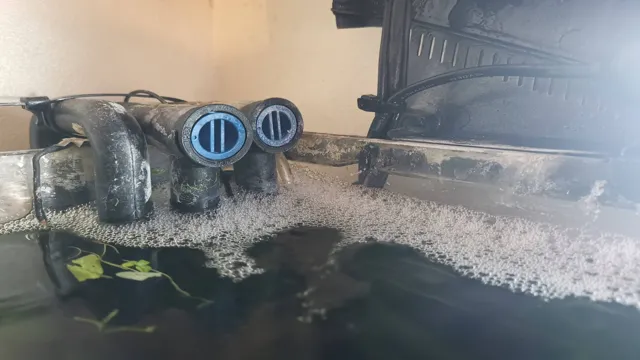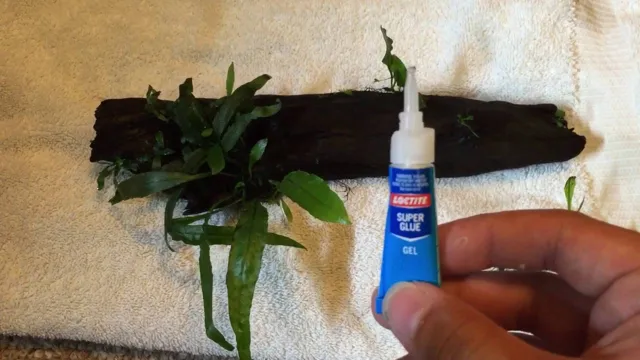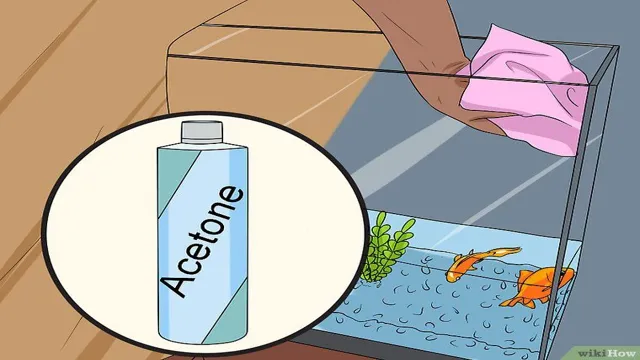Have you ever gazed into your aquarium only to be distracted by seemingly endless bubbles? While bubbles can be a charming addition to your tank, too many can become an issue for your aquatic pets and overall aquarium function. Not to mention, excessive bubbles can hinder the clarity and aesthetic appeal of your setup. Luckily, removing bubbles from your aquarium is a simple process that can be accomplished in no time with the right tools and techniques! In this article, we will explore various ways to remove bubbles from your aquarium, ensuring happy fish and a stunning underwater view.
So, let’s dive in!
Identify the Cause of Bubbles
Have you ever wondered how to get bubbles out of your aquarium? Before answering that question, it’s essential to understand the cause of bubbles in the first place. Bubbles in an aquarium can arise due to several reasons, including high water flow or filter output, changes in water pressure, or high levels of dissolved gases. It’s crucial to identify the specific cause of bubbles in your aquarium to address the issue effectively.
For instance, reducing water flow or adjusting the filter output can reduce the number of bubbles in your aquarium. Additionally, adding an air stone or lowering the water temperature can help alleviate any problems with high levels of dissolved gases. By understanding the root cause, you can eliminate bubbles from your aquarium and create an optimal aquatic environment for your fish.
Are the bubbles coming from an air stone or filter?
If you see bubbles in your aquarium, the first thing to consider is whether they are coming from an air stone or filter. If the bubbles are coming from an air stone, then it’s a clear indication that you have an aeration setup in your aquarium. An air stone helps in increasing oxygen levels in the water, preventing fish from suffocating.
On the other hand, if the bubbles are coming from your filter, it may be a sign that the setup is working correctly. Filters are designed to create a certain level of surface agitation that helps to oxygenate the water by producing tiny air bubbles. The air bubbles move the water around, which promotes gas exchange between the atmosphere and the water, ensuring healthy and clean water for your fish.
Therefore, it is important to know where the bubbles are coming from in your aquarium as it indicates the proper functioning of your equipment.

Are there any fish or plants creating the bubbles?
When you see bubbles in your aquarium, it’s natural to wonder what’s causing them. It could be fish or plants producing oxygen, or it could be a sign of a problem. If the bubbles seem to be coming from the surface, it’s likely that your filter is creating them as it removes waste from the water.
This is nothing to worry about and in fact, it’s good news! It means your filter is working to keep your aquarium clean and healthy. On the other hand, bubbles coming from the substrate can be a sign of anaerobic bacteria breaking down organic material. This can lead to dangerous pockets of gas forming in the substrate, which can harm your fish.
If you suspect this may be the case, it’s important to remove any built-up debris and increase water circulation to prevent this from happening. By examining the location and nature of the bubbles in your aquarium, you can identify the cause and take any necessary steps to keep your fish and plants healthy.
Adjust the Water Flow
If you’re finding bubbles constantly marring the aesthetic of your aquarium, then it’s time to make some adjustments to the water flow. One of the main reasons for bubbles in an aquarium is the water flow being too strong and causing turbulence, which leads to bubbles forming on the surface. To combat this, try reducing the flow of the filter or pump to a moderate level.
You can also install a diffuser to reduce the force of the water flow, which can help prevent bubbles from forming. Keep in mind that having some bubbles in the aquarium is natural and helps with oxygenation, so aim to find a balance that works best for your aquatic pets and the overall look of your aquarium. With a little bit of experimentation and observation, you can easily get rid of unwanted bubbles in your aquarium and make it truly sparkle. (See Also: How to Calculate Glass Thickness for Aquarium: A Comprehensive Guide)
Reduce the flow rate of filters and pumps to reduce agitation
When it comes to keeping your aquarium clean and healthy, it’s important to remember that less can often be more. One easy way to reduce agitation in your tank is to adjust the flow rate of your filters and pumps. High flow rates can create a lot of turbulence, which can stress out your fish and even damage delicate plants and coral.
By lowering the flow rate, you can create a more peaceful environment that still circulates water effectively. This can also help to reduce energy usage and save on your electric bill. So don’t be afraid to experiment with different flow rates and find the sweet spot that works best for your aquarium.
Your fish and plants will thank you for it!
Position the outflow of water from the filter to reduce surface turbulence
When it comes to setting up a filter in your aquarium, it’s important to consider how the water flow is impacting the surface of the water. One of the key factors to keep in mind is reducing surface turbulence as much as possible. This can be achieved by carefully positioning the outflow of water from the filter.
By pointing the outflow towards the side or corner of the tank, it will create a gentle current that moves the water around in a more controlled way. This is important because excessive turbulence can cause stress for your fish, as well as increase the evaporation rate of your tank. Finding the right balance of water flow can take some trial and error, but with a little practice, you can ensure that your aquarium environment is comfortable and healthy for all of its inhabitants.
So keep this in mind when setting up your filter, and remember to regularly monitor the water flow to ensure that it’s meeting the needs of your aquatic pets.
Use Antifoaming Agents
If you’re dealing with excess bubbles in your aquarium, you may want to consider using antifoaming agents. These agents are specifically designed to break up and remove bubbles from the water, leaving your aquarium looking clean and clear. However, it’s essential to choose the right type of antifoaming agent for your specific needs, as some may contain chemicals or additives that could harm your fish or other aquatic life.
Before adding any antifoaming agent to your aquarium, read the label carefully and do your research to ensure that it’s safe and effective for your specific situation. By using antifoaming agents correctly, you can quickly and easily get rid of pesky bubbles and maintain a healthy and beautiful aquarium.
Purchase aquarium-safe antifoaming agents to control bubbles
If you’re tired of seeing endless bubbles forming in your aquarium, antifoaming agents can help. These products effectively control the foam created by protein skimmers, air stones, and other equipment without harming your aquatic pets. When looking for antifoaming agents, it’s essential to select ones that are safe for aquarium use.
Some products contain harmful ingredients that can harm your fish, invertebrates, and plants. Good options are those made from silicone-based and food-grade materials. These agents are easy to use, simply adding a few drops to your aquarium water to control bubbling.
As with any chemical added to your aquarium, follow the product’s instructions carefully, and avoid overdosing. By using an antifoaming agent, you can enjoy a clearer, calmer, and more comfortable aquarium environment for your pets. (See Also: How to Get to Twisted Aquarium MapleStory: Your Ultimate Guide to Navigating the Maze)
Dosage should be based on the volume of water in your aquarium
When adding antifoaming agents to your aquarium, it’s important to consider the dosage based on the volume of water in your tank. Using too little can result in ineffective results, while using too much can harm your aquatic inhabitants. It’s always best to start with a smaller dosage and gradually increase if needed.
Antifoaming agents work to reduce the surface tension in the water, allowing for stubborn bubbles to break and disperse. This can be especially useful in aquariums with high levels of agitation, such as those with protein skimmers or bubbling decorations. By using the appropriate dosage and a high-quality antifoaming agent, you can ensure a healthy and beautiful aquarium environment for all of your underwater friends.
Maintain Regular Tank Maintenance
If you’re wondering how to get bubbles out of your aquarium, it’s essential to maintain regular tank maintenance. One of the primary reasons for bubbles is excess food, waste, or debris that builds up in the tank over time. Ensuring that you keep the tank clean, regularly change the water, and clean the filter will help to prevent excessive bubbles and other potential issues.
Another way to prevent bubbles in the aquarium is to avoid overfeeding the fish, as uneaten food can accumulate at the bottom, leading to excess bubbles. It’s also essential to ensure that the air pump and other equipment are working correctly and not causing excessive agitation or unnecessary bubbles. By keeping up with tank maintenance and ensuring that the environment is healthy and balanced, you can reduce the likelihood of bubbles in your aquarium and keep your fish happy and healthy.
Regularly clean filters, pumps, and air stones
Maintaining regular tank maintenance is crucial to keep your fish healthy and happy. One of the most vital maintenance tasks is cleaning the filters, pumps, and air stones. Regular cleaning prevents the build-up of debris, dirt, and harmful chemicals, ensuring a clean and healthy environment for your fish.
Filters, pumps, and air stones work together to keep the water clean, oxygenated, and free from toxins. If not maintained adequately, they can quickly become clogged, leading to poor water quality and damaging effects on the health of fish. So, it’s essential to incorporate regular cleaning in your fish tank maintenance routine.
Doing so will not only keep your fish happy and healthy but also extend the lifespan of your equipment, saving you money on repairs and replacements. Remember, your fish depend on you to maintain a clean and healthy environment, so don’t neglect your tank’s maintenance.
Perform water changes to reduce organic build-up in the tank
Performing regular water changes is one of the most crucial aspects of maintaining a healthy tank. It helps in reducing organic build-up in the tank, which can be dangerous for the aquatic life. Organic build-up mainly occurs due to leftover food, fish waste, and other debris that accumulate at the bottom of the tank.
This debris releases harmful toxins that can be toxic to fish and other aquatic creatures. To prevent this, replace 10-15% of the water in the tank once a week. A freshly replenished tank with clean water will keep your fish happy and healthy.
Moreover, make sure to clean the substrate, filter, and any decorations inside the tank. This will help in reducing the organic build-up in the tank and decrease the workload on the filter. Taking care of your aquarium regularly will help prevent unnecessary complications like infections, diseases and premature death of your aquatic pets.
Conclusion
In conclusion, the key to successfully removing bubbles from your aquarium is to employ a combination of patience and strategy. With a few simple adjustments to your tank’s water flow, surface agitation, and overall maintenance routine, you can eliminate those pesky bubbles and enjoy a clear, peaceful aquatic environment. Just remember, much like life itself, achieving a bubble-free aquarium requires equal parts science and art – and a healthy dose of humor can’t hurt either. (See Also: How to Feed Live Micro Worms to Your Aquarium Fish: A Beginner’s Guide)
So, roll up your sleeves and get ready to pop those bubbles like a pro – your fish (and your inner scientist) will thank you for it.”
FAQs
Why do bubbles appear in my aquarium?
Bubbles can appear in your aquarium due to several reasons, including air stones, filters, agitation from water movement, or excess protein and organic matter.
Can bubbles harm my fish?
In most cases, bubbles are harmless to fish. However, increased bubble production can mean an accumulation of dissolved gases, which can be harmful to fish in high concentrations.
How can I reduce excess bubbles in my aquarium?
You can reduce excess bubbles by adjusting your filter’s water flow rate, checking for air leaks in your air stones or tubing, and reducing organic matter by performing regular water changes.
Can I add chemicals to eliminate bubbles?
It is not recommended to add chemicals to your aquarium to eliminate bubbles as they can cause harm to your fish and aquatic plants.
How often should I clean my air stone to prevent excessive bubbles?
It is recommended to clean your air stone once a month to prevent clogging and excess bubble production.
Are there any natural ways to reduce excess bubbles in my aquarium?
Yes, you can add live aquatic plants, which can help absorb excess gases and reduce bubble production. Additionally, a decrease in feeding and maintaining a clean aquarium can also help reduce bubbles.
Is it normal to see bubbles on the surface of the water in my aquarium?
Yes, bubbles on the surface of the water are normal and can indicate healthy water circulation and oxygenation. However, if you notice an excessive amount of bubbles, it may be worth investigating the cause.







